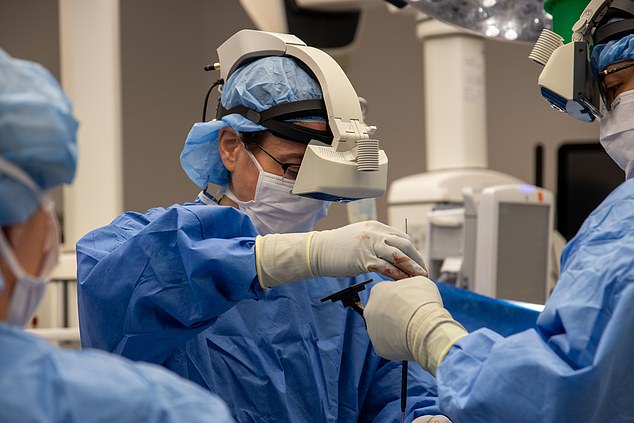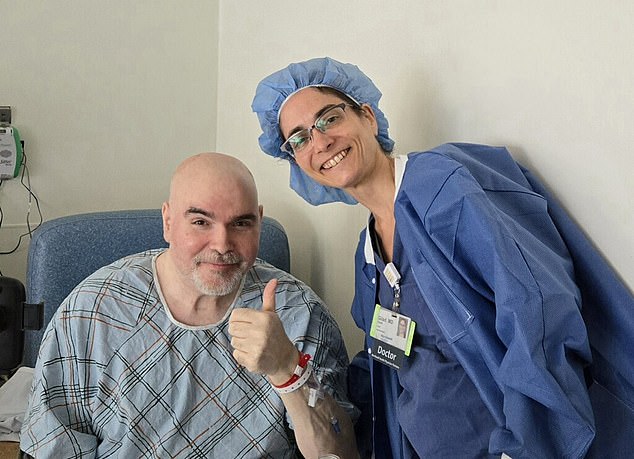Father with spine-shattering condition can walk and play guitar again thanks to ‘miraculous’ augmented reality headset
Samuel Cerami, 53, was willing to try anything after four years of neck pain and numb limbs became unbearable.
His severe spinal cord injury made it nearly impossible for him to walk and he could barely get out of bed.
“Being afraid to walk up five flights of stairs to get to the bathroom is not the way to live. I had no strength or enthusiasm to do anything,” he told DailyMail.com.
The former work planner from Staten Island, New York, had severe spinal stenosis, in which the nerves are pinched by a narrowing of the vertebrae.
Constant pain strained his relationship with his wife and two daughters, making him irritable and unpleasant at times, and prevented him from playing his beloved bass guitar.
MISERY: Samuel Cerami before groundbreaking surgery to fix his spine-crushing condition

BACK TO BASS-ics: After resigning himself to the idea of never playing again, he is back making music and doing what he loves
He was scheduled to undergo his fourth surgery last month to relieve pressure on his spine.
The last three operations had failed and he had come to the realization that he would be in pain for the rest of his life.
But that all changed when he received a call from his neurosurgeon, Dr. Ronit Gilad of Staten Island University Hospital, that changed his life.
Dr. Gilad experimented with a new headset that could improve the accuracy and efficiency of spinal procedures.
The headset allows surgeons to see the real world, but with virtual screens in front of them displaying important information. This is called augmented reality.
Dr. Gilad had been treating Mr. Cerami since 2020. When she found out she was going to bring this technology into the operating room, she thought of him.
Mr. Cerami said, “I honestly wasn’t nervous at all when she called. I had 100 percent confidence in whatever she was going to do.”
The headset allowed Dr. Gilad to get a full view of Mr. Cerami’s spine without having to look at a monitor. According to the SIUH, the headset provided “unprecedented accuracy and control during a spinal procedure.”
Dr. Gilad made two “tiny” incisions in his lower back. She used the headset to navigate his spine and placed an expandable cage between his discs to correct the curvature. She inserted screws and rods for stability.
This is less invasive than traditional surgery, which requires a larger incision.
She explains: ‘This headset has a screen, it’s a kind of virtual reality video game that creates a three-dimensional model of the spine and merges it with the GPS system that we have in the operating room.
“It’s a total game changer.”

The headset allows surgeons to see the real world, but with virtual screens in front of them displaying key information – also known as augmented reality.
Dr. Gilad described the original method as follows: “You should open his back and visualize the spine in front of you.”
Within three weeks of his recovery, Mr. Cerami was able to run errands for five hours, compared to just five minutes before surgery.
He was able to spend time with family and friends again in a pleasant way and enjoy his favorite hobbies.
Cerami said, “It was like a miracle. This is absolutely the future of medicine.”
Cerami happily reported that about a month after the surgery he was able to play bass guitar for hours, the first time he had been able to do that in four years.
Cerami said, “For me, it was so minimally invasive that I was more nervous about having my tooth pulled.
‘I couldn’t sleep that night (after the surgery), I think I was just so excited that I wasn’t in pain anymore. I didn’t feel the anesthesia anymore.
“This is the best I’ve felt in three years. I’m sure the thing they used was definitely a big part of that.”
Cerami was expected to remain in the hospital for three days, but was sent home the next day.
And he is still recovering quickly.

Mr. Cerami and Dr. Gilad after the ‘miracle’ operation
Spinal stenosis and other degenerative conditions are common in older patients. The risk of developing them increases with age.
According to the Cleveland Clinic, about 95 percent of Americans age 50 and older suffer from this.
But only about 250,000 to 500,000 Americans have spinal stenosis specifically. People can have spinal stenosis without any symptoms, unlike Mr. Cerami.
Aging, arthritis and previous injuries can cause spinal stenosis. Mr. Cerami said he was born with the condition but had no symptoms until four years ago.
According to the Mayo Clinic, only 9 percent of cases of spinal stenosis are genetic.
Mr. Cerami’s first back surgery was the fusion of a titanium plate to his spine through the front of his neck in 2020. After the surgery, he had to wear a neck brace for six weeks.
But this surgery did not decompress his spine enough to relieve his pain. Dr. Gilad operated a second time about two months later, this time adding rods to the back of his neck for more spinal support.
Mr. Cerami said, “My entire neck has been rebuilt with titanium.”
He thought he was on the road to recovery. Mr. Cerami did physical therapy, but soon found his lower back was in excruciating pain. He had no choice but to undergo another surgery.

The constant pain put a strain on his relationships with his wife and two daughters, making him irritable and unpleasant to be around at times.
The third operation in 2023 on his spinal column via his lower back did not relieve Mr. Cerami’s pain.
He struggled for another year, until he underwent another routine operation in July to decompress his nerves and correct the shape of his spine.
But plans changed when Dr. Gilad said Mr. Cerami was a candidate for the procedure with the new device.
The augmented reality headset is manufactured by Augmedics and is called the Xvision Spine System. According to SIUH, it was introduced to hospitals in 2019.
The first hospital to use the Xvision Spine System was Johns Hopkins Hospital in Maryland in 2020.
SIUH was the second hospital in New York to use the device. It was introduced at the hospital about a month before Mr. Cerami’s surgery.
Dr. Gilad practiced operating with the headset on spinal models with artificial skin and tissue before testing her skills on Cerami.
Dr Gilad believes it will revolutionise spinal surgery as it is “certainly more accurate” than traditional methods as the surgeon does not have to divert his gaze during the operation.
Gilad summarized the benefits of using xvision technology more often: “It will reduce the operating time.
“It makes incisions smaller, improves accuracy, reduces patient stay in the hospital, and ultimately improves outcomes and patient satisfaction.”
According to the SIUH, the Xvision Spine System is FDA-cleared for both open and minimally invasive surgeries such as those used by Cerami.
So far, the device has been used to treat more than 6,500 patients in 24 states.
